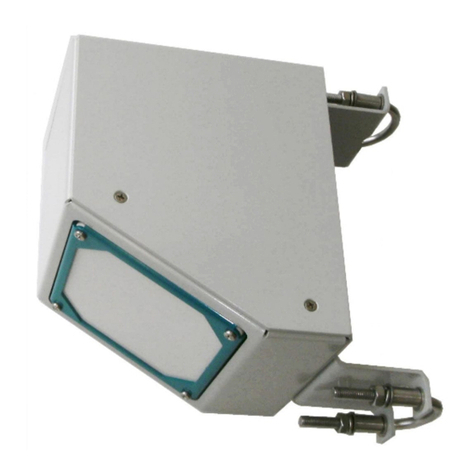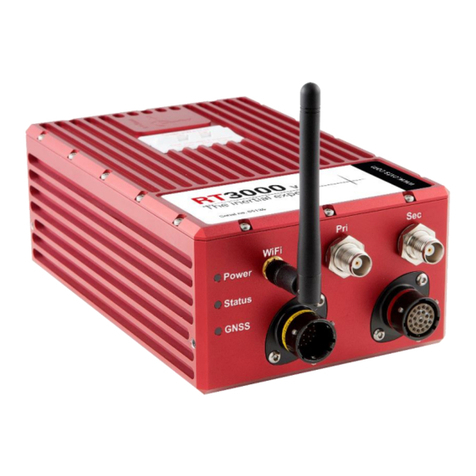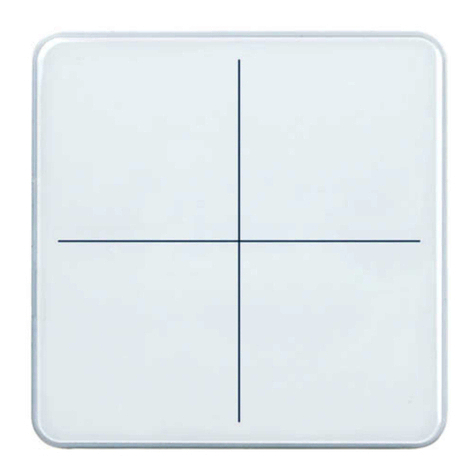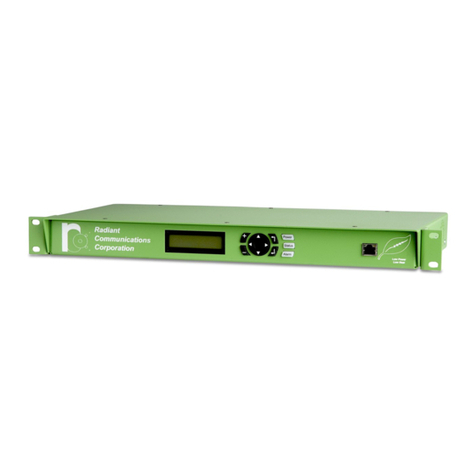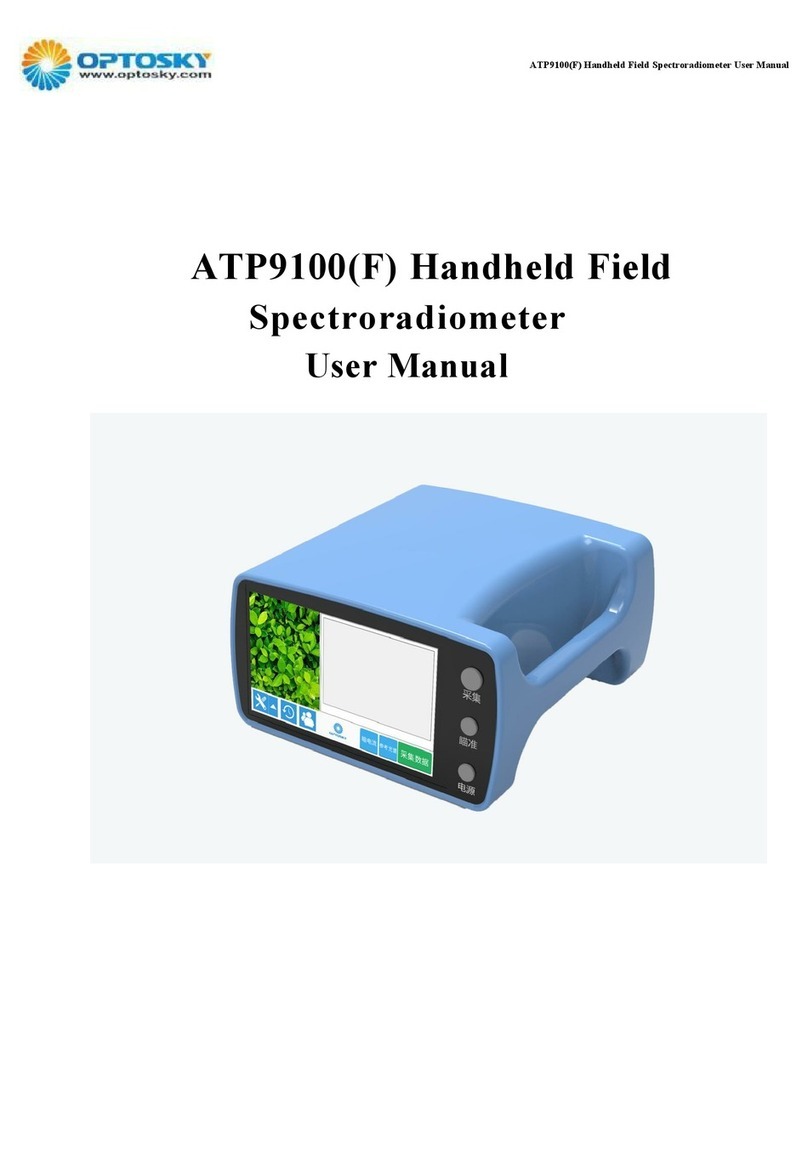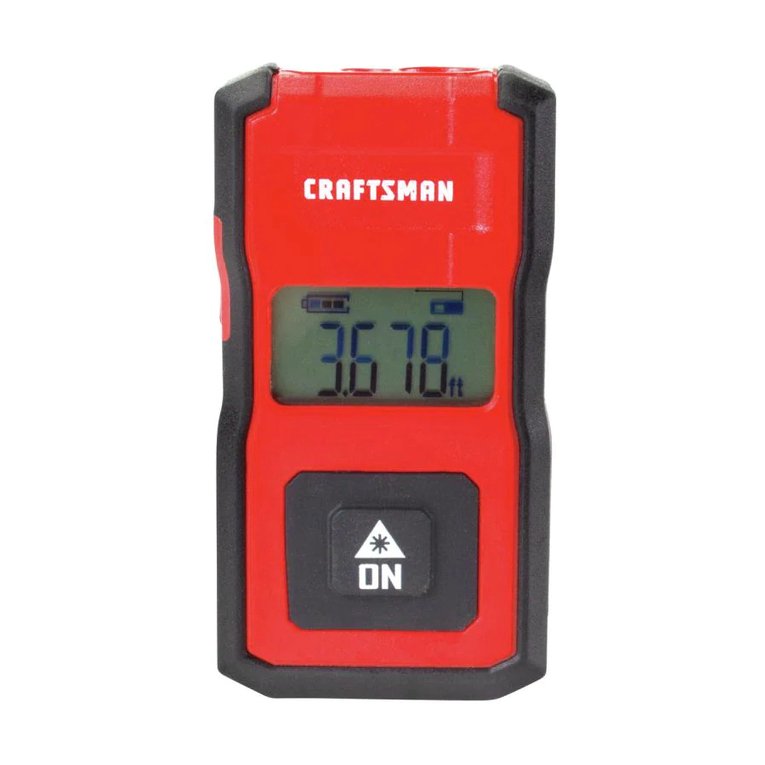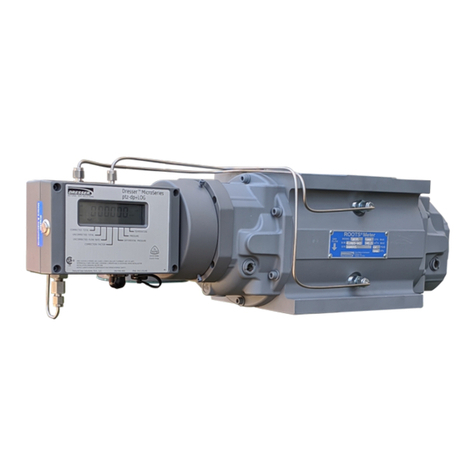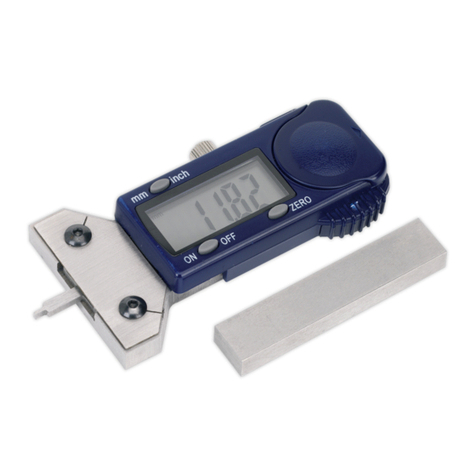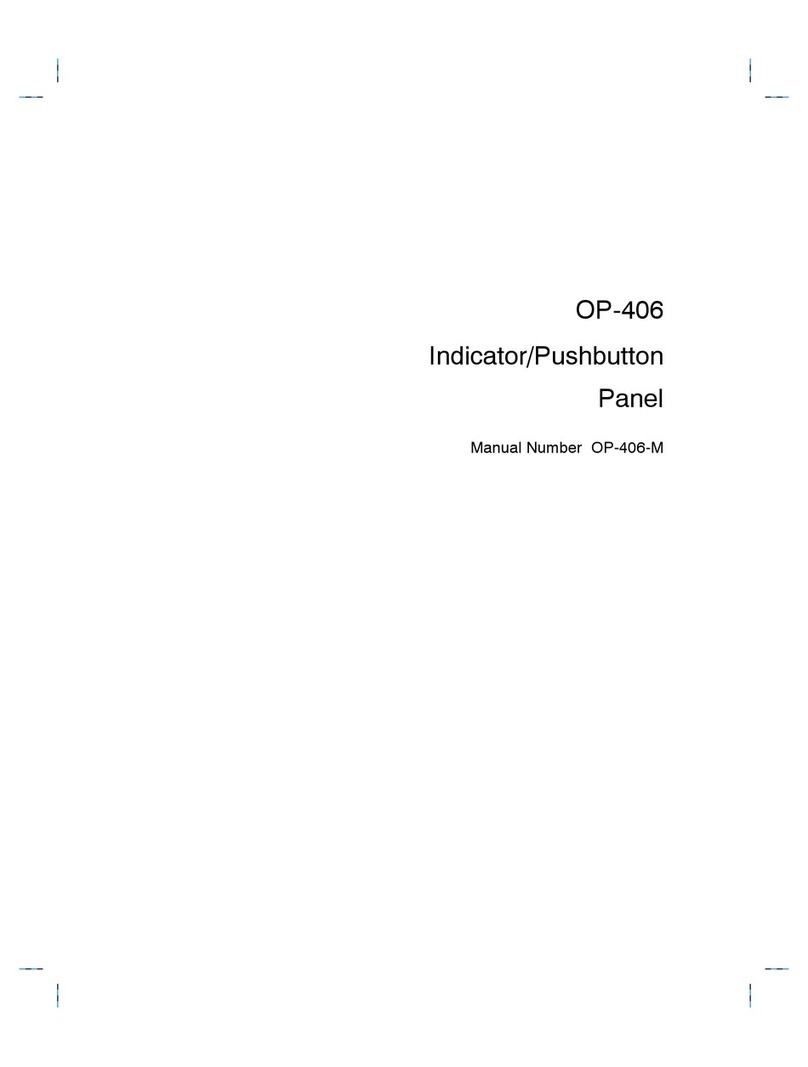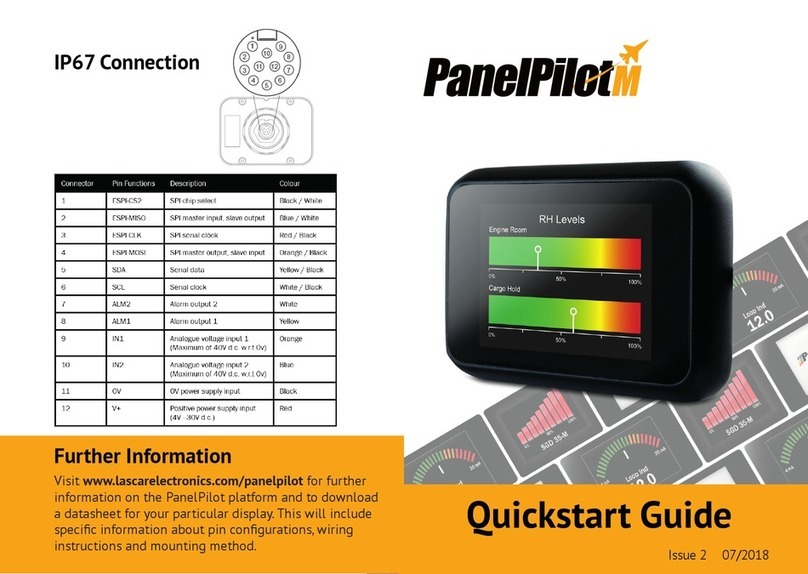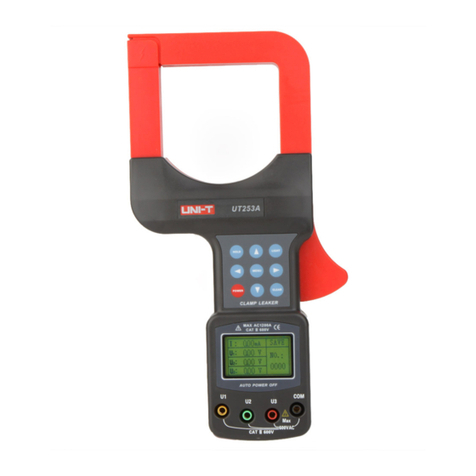Chadwick-Helmuth Vibrex 2000 Plus User manual

User Guide No. 13841-6
August 1, 2002
VibrexTM 2000
and
Vibrex 2000 Plus
User Guide
Digital Dynamic Balancer/Analyzer
Systems
Chadwick-Helmuth

ii Chadwick-Helmuth Company, Inc.
Company, Inc.
Copyright Notice
Copyright ©2000, 2001, 2002 by Chadwick-Helmuth Company, Inc.
All Rights Reserved
Fifth Edition, April 2003
Printed in the U.S.A.
This User Guide is supplied to the User under license, subject to change
without notice and/or recall by Chadwick-Helmuth Company, Inc., at any
time. The User Guide at all times remains the property of Chadwick-
Helmuth Company, Inc. The information contained in this User Guide is
considered confidential. No part of this User Guide is to be copied or
reproduced or transmitted in any form whatever (including orally or by
electronic transmission), nor is any information in this User Guide to be
disclosed in any form whatever (including orally or by electronic
transmission) to anyone other than an authorized representative of the
User's employer who also shall agree not to disclose same, without
express prior written consent of Chadwick-Helmuth Company, Inc.
Trademarks
Vibrex is a trademark of the Chadwick-Helmuth Company, Inc.
Excel, MS-DOS, Windows, Windows NT, and Windows 95 are
trademarks of the Microsoft Corporation.
IBM, IBM-PC, and Lotus 1-2-3 are trademarks of the IBM Corporation.
Chadwick-Helmuth Company, Inc.
4601 N. Arden Drive
El Monte, CA 91731
(626) 575-6161
Fax: (626) 350-4236
E-mail: Chadwick@chadwick-helmuth.com

Vibrex 2000 and Vibrex 2000 Plus User Guide iii
Contents
Quick Reference Guide . . . . . . . . . . . . . . . . . . . . . . . . . . ix
Chapter 1. Introduction . . . . . . . . . . . . . . . . . . . . . . . . . . .1
1.1 About This User Guide . . . . . . . . . . . . . . . . . . . . . . . . . . . . . . . . 1
1.1.1 Organization. . . . . . . . . . . . . . . . . . . . . . . . . . . . . . . . . . . . 2
1.1.2 Notice Formats. . . . . . . . . . . . . . . . . . . . . . . . . . . . . . . . . . 2
1.1.3 Document Conventions . . . . . . . . . . . . . . . . . . . . . . . . . . . 3
1.1.4 Reference Documentation . . . . . . . . . . . . . . . . . . . . . . . . . 3
1.2 Product Support. . . . . . . . . . . . . . . . . . . . . . . . . . . . . . . . . . . . . . 4
1.2.1 Fax Service . . . . . . . . . . . . . . . . . . . . . . . . . . . . . . . . . . . . 4
1.2.2 Internet Service . . . . . . . . . . . . . . . . . . . . . . . . . . . . . . . . . 4
Chapter 2. System Overview . . . . . . . . . . . . . . . . . . . . . . . 5
2.1 Vibrex Systems: Introduction . . . . . . . . . . . . . . . . . . . . . . . . . . . 5
2.2 Product Description. . . . . . . . . . . . . . . . . . . . . . . . . . . . . . . . . . . 6
2.2.1 Vibrex 2000 System Overview . . . . . . . . . . . . . . . . . . . . . 6
2.2.1.1 System Operations . . . . . . . . . . . . . . . . . . . . . . . . . . 7
2.2.1.2 System Benefits . . . . . . . . . . . . . . . . . . . . . . . . . . . . 8
2.2.1.3 Self-Test Feature . . . . . . . . . . . . . . . . . . . . . . . . . . . 8
2.2.2 Vibrex 2000 Plus Enhancements. . . . . . . . . . . . . . . . . . . . 9
2.3 System Specifications . . . . . . . . . . . . . . . . . . . . . . . . . . . . . . . . 10
2.3.1 Vibrex 2000 Specifications . . . . . . . . . . . . . . . . . . . . . . . 10
2.3.2 Vibrex 2000 Plus Specifications . . . . . . . . . . . . . . . . . . . 13
Chapter 3. Getting Started . . . . . . . . . . . . . . . . . . . . . . . . 17
3.1 Getting Started: Introduction. . . . . . . . . . . . . . . . . . . . . . . . . . . 17
3.2 Basic Features . . . . . . . . . . . . . . . . . . . . . . . . . . . . . . . . . . . . . . 18

Contents
iv Chadwick-Helmuth Company, Inc.
3.2.1 Display . . . . . . . . . . . . . . . . . . . . . . . . . . . . . . . . . . . . . . . 19
3.2.1.1 Adjusting Screen Contrast. . . . . . . . . . . . . . . . . . . . 19
3.2.1.2 Screen Operations . . . . . . . . . . . . . . . . . . . . . . . . . . 19
3.2.1.3 Self-Test Screen . . . . . . . . . . . . . . . . . . . . . . . . . . . 20
3.2.2 Keypad . . . . . . . . . . . . . . . . . . . . . . . . . . . . . . . . . . . . . . . 20
3.2.2.1 Alpha-Numeric Keys. . . . . . . . . . . . . . . . . . . . . . . . 20
3.2.2.2 Dedicated Keys . . . . . . . . . . . . . . . . . . . . . . . . . . . . 21
3.2.2.3 Context Keys. . . . . . . . . . . . . . . . . . . . . . . . . . . . . . 22
3.2.3 Channel Configuration . . . . . . . . . . . . . . . . . . . . . . . . . . . 22
3.3 Printing Data. . . . . . . . . . . . . . . . . . . . . . . . . . . . . . . . . . . . . . . . 23
3.3.1 Direct Serial Printing . . . . . . . . . . . . . . . . . . . . . . . . . . . . 23
3.3.1.1 Basic Settings . . . . . . . . . . . . . . . . . . . . . . . . . . . . . 24
3.3.1.2 Connecting the Printer. . . . . . . . . . . . . . . . . . . . . . . 24
3.3.2 Printing With a PC . . . . . . . . . . . . . . . . . . . . . . . . . . . . . . 27
3.3.2.1 Downloading Data. . . . . . . . . . . . . . . . . . . . . . . . . . 27
3.3.3 Reading FFT Data. . . . . . . . . . . . . . . . . . . . . . . . . . . . . . . 29
3.3.4 Using the PRINT Key. . . . . . . . . . . . . . . . . . . . . . . . . . . . 30
3.3.4.1 Global Printing . . . . . . . . . . . . . . . . . . . . . . . . . . . . 31
3.3.4.2 Printing With REVIEW and PRINT Keys . . . . . . . 33
Chapter 4. Installation. . . . . . . . . . . . . . . . . . . . . . . . . . . 35
4.1 Installation: Introduction . . . . . . . . . . . . . . . . . . . . . . . . . . . . . . 35
4.2 Vibrex 2000 Basic Equipment . . . . . . . . . . . . . . . . . . . . . . . . . . 36
4.2.1 V2K Propeller Balance Kits . . . . . . . . . . . . . . . . . . . . . . . 36
4.2.1.1 V2K Single-Engine Kits . . . . . . . . . . . . . . . . . . . . . 37
4.2.1.2 V2K Twin-Engine Kits . . . . . . . . . . . . . . . . . . . . . . 38
4.2.2 V2K Rotor Track & Balance Kits. . . . . . . . . . . . . . . . . . . 39
4.2.3 V2K Helicopter and Fixed Wing Kit . . . . . . . . . . . . . . . . 40
4.3 Vibrex 2000 Plus Equipment . . . . . . . . . . . . . . . . . . . . . . . . . . . 41
4.3.1 V2K Plus Propeller Balance Kits . . . . . . . . . . . . . . . . . . . 42
4.3.1.1 V2K Plus Single-Engine Kit. . . . . . . . . . . . . . . . . . 42
4.3.1.2 V2K Plus Twin-Engine Kit. . . . . . . . . . . . . . . . . . . 43
4.3.2 V2K Plus Rotor Track & Balance Kit . . . . . . . . . . . . . . . 44
4.3.3 V2K Plus Helicopter & Fixed Wing Kit. . . . . . . . . . . . . . 45
4.3.4 Optional Equipment . . . . . . . . . . . . . . . . . . . . . . . . . . . . . 47
4.3.5 Carrying Case . . . . . . . . . . . . . . . . . . . . . . . . . . . . . . . . . . 48

Contents
Vibrex 2000 and Vibrex 2000 Plus User Guide v
4.4 General Installation . . . . . . . . . . . . . . . . . . . . . . . . . . . . . . . . . . 48
4.4.1 Velocimeters . . . . . . . . . . . . . . . . . . . . . . . . . . . . . . . . . . 50
4.4.2 Photocell System . . . . . . . . . . . . . . . . . . . . . . . . . . . . . . . 51
4.4.2.1 Retro-Reflective Target . . . . . . . . . . . . . . . . . . . . . 52
4.4.2.2 General Photocell Use . . . . . . . . . . . . . . . . . . . . . . 53
4.4.2.3 Repair of Photocell Wiring. . . . . . . . . . . . . . . . . . . 53
4.4.2.4 Photocell Placement. . . . . . . . . . . . . . . . . . . . . . . . 54
4.4.2.5 Target Positioning . . . . . . . . . . . . . . . . . . . . . . . . . 56
4.4.3 Magnetic Pickup . . . . . . . . . . . . . . . . . . . . . . . . . . . . . . . 57
4.5 Sample Installations . . . . . . . . . . . . . . . . . . . . . . . . . . . . . . . . . 59
4.5.1 Lycoming O/IO-320/360 . . . . . . . . . . . . . . . . . . . . . . . . . 59
4.5.2 Lycoming O/IO-540 . . . . . . . . . . . . . . . . . . . . . . . . . . . . 59
4.5.3 Continental O/IO-470/520/550 . . . . . . . . . . . . . . . . . . . . 59
4.5.4 P&W R-985/2800 . . . . . . . . . . . . . . . . . . . . . . . . . . . . . . 59
4.5.5 Flat Opposed General Rules . . . . . . . . . . . . . . . . . . . . . . 60
4.5.6 Radial Engine General Rules. . . . . . . . . . . . . . . . . . . . . . 60
4.5.7 Turbine Engines. . . . . . . . . . . . . . . . . . . . . . . . . . . . . . . . 60
4.5.8 Geared Reciprocating Engines. . . . . . . . . . . . . . . . . . . . . 60
Chapter 5. General Operation . . . . . . . . . . . . . . . . . . . . . 61
5.1 Operation: Introduction. . . . . . . . . . . . . . . . . . . . . . . . . . . . . . . 61
5.2 Beginning Operation . . . . . . . . . . . . . . . . . . . . . . . . . . . . . . . . . 62
5.2.1 Powering Up . . . . . . . . . . . . . . . . . . . . . . . . . . . . . . . . . . 62
5.2.2 Main Menu Screen. . . . . . . . . . . . . . . . . . . . . . . . . . . . . . 63
5.3 Basics of Operation. . . . . . . . . . . . . . . . . . . . . . . . . . . . . . . . . . 65
5.4 Propeller Balancing. . . . . . . . . . . . . . . . . . . . . . . . . . . . . . . . . . 66
5.4.1 Propeller Balance Setup. . . . . . . . . . . . . . . . . . . . . . . . . . 68
5.4.1.1 Entering Aircraft IDs . . . . . . . . . . . . . . . . . . . . . . . 68
5.4.1.2 Selecting Channels. . . . . . . . . . . . . . . . . . . . . . . . . 69
5.4.1.3 Entering Horsepower . . . . . . . . . . . . . . . . . . . . . . . 70
5.4.1.4 Setting Sensitivity . . . . . . . . . . . . . . . . . . . . . . . . . 72
5.4.1.5 Multiple Propeller Feature . . . . . . . . . . . . . . . . . . . 75
5.4.2 Acquiring Balance Readings . . . . . . . . . . . . . . . . . . . . . . 77
5.4.2.1 Annotating the Reading . . . . . . . . . . . . . . . . . . . . . 79
5.4.2.2 Balance Quality Indicator. . . . . . . . . . . . . . . . . . . . 79

Contents
vi Chadwick-Helmuth Company, Inc.
5.4.3 Obtaining Balance Solutions. . . . . . . . . . . . . . . . . . . . . . . 81
5.4.3.1 Application Guidelines . . . . . . . . . . . . . . . . . . . . . . 81
5.4.3.2 Using the Propeller Protractor. . . . . . . . . . . . . . . . . 82
5.4.3.3 Changing Performed Solutions . . . . . . . . . . . . . . . . 84
5.4.4 Finishing Propeller Balance . . . . . . . . . . . . . . . . . . . . . . . 84
5.4.4.1 If Unable To Use Weight Azimuth. . . . . . . . . . . . . 85
5.4.5 Reviewing Balance Histories . . . . . . . . . . . . . . . . . . . . . . 86
5.4.5.1 Reviewing Propeller Balance Measurements . . . . . 87
5.4.5.2 Reviewing Other Balance Measurements. . . . . . . . 88
5.4.5.3 Reviewing Spectrum Peak Measurements . . . . . . . 89
5.4.5.4 Reviewing Spectrum Order Analysis . . . . . . . . . . . 89
5.4.5.5 Clearing Runs, Measurements, and Lists . . . . . . . . 89
5.5 Helicopter Rotor Balancing . . . . . . . . . . . . . . . . . . . . . . . . . . . . 90
5.5.1 Main Rotor Track . . . . . . . . . . . . . . . . . . . . . . . . . . . . . . . 92
5.5.2 Main Rotor Balance . . . . . . . . . . . . . . . . . . . . . . . . . . . . . 94
5.5.3 Using the Rotor Protractor . . . . . . . . . . . . . . . . . . . . . . . .96
5.5.3.1 Counter-Clockwise Rotor Correction . . . . . . . . . . 100
5.5.3.2 Clockwise Rotor Correction . . . . . . . . . . . . . . . . . 104
5.5.4 Tail Rotor Balance . . . . . . . . . . . . . . . . . . . . . . . . . . . . . 104
5.5.4.1 Clockwise Rotors . . . . . . . . . . . . . . . . . . . . . . . . . 105
5.5.4.2 Counter-Clockwise Rotors . . . . . . . . . . . . . . . . . . 105
5.5.5 Tail Rotor Track . . . . . . . . . . . . . . . . . . . . . . . . . . . . . . . 106
5.6 Spectrum Analysis . . . . . . . . . . . . . . . . . . . . . . . . . . . . . . . . . . 109
5.6.1 Spectrum Analysis Setup . . . . . . . . . . . . . . . . . . . . . . . . 109
5.6.1.1 Ranging Feature . . . . . . . . . . . . . . . . . . . . . . . . . . 111
5.6.1.2 Annotating Spectra . . . . . . . . . . . . . . . . . . . . . . . . 111
5.6.2 Collecting Spectral Data. . . . . . . . . . . . . . . . . . . . . . . . . 111
5.6.3 Order Analysis . . . . . . . . . . . . . . . . . . . . . . . . . . . . . . . . 112
5.6.4 Spectrum Viewer Feature . . . . . . . . . . . . . . . . . . . . . . . . 114
5.6.4.1 After Taking Measurements . . . . . . . . . . . . . . . . . 114
5.6.4.2 Displaying Cursor Data. . . . . . . . . . . . . . . . . . . . . 116
Chapter 6. Maintenance . . . . . . . . . . . . . . . . . . . . . . . . 117
6.1 Maintenance: Introduction . . . . . . . . . . . . . . . . . . . . . . . . . . . . 117
6.2 Theory of Operation. . . . . . . . . . . . . . . . . . . . . . . . . . . . . . . . . 118
6.2.1 Digital Subsystem. . . . . . . . . . . . . . . . . . . . . . . . . . . . . . 118

Contents
Vibrex 2000 and Vibrex 2000 Plus User Guide vii
6.2.2 Display Subsystem. . . . . . . . . . . . . . . . . . . . . . . . . . . . . 119
6.2.3 Analog Subsystem . . . . . . . . . . . . . . . . . . . . . . . . . . . . . 119
6.2.3.1 Velocity Signal. . . . . . . . . . . . . . . . . . . . . . . . . . . 119
6.2.3.2 Azimuth Signal. . . . . . . . . . . . . . . . . . . . . . . . . . . 120
6.2.4 Power Subsystem. . . . . . . . . . . . . . . . . . . . . . . . . . . . . . 121
6.2.4.1 Battery Power. . . . . . . . . . . . . . . . . . . . . . . . . . . . 121
6.2.4.2 On-Off Logic . . . . . . . . . . . . . . . . . . . . . . . . . . . . 121
6.2.4.3 Power Supplies. . . . . . . . . . . . . . . . . . . . . . . . . . . 121
6.2.4.4 Short-circuit Protection . . . . . . . . . . . . . . . . . . . . 122
6.3 Routine Servicing . . . . . . . . . . . . . . . . . . . . . . . . . . . . . . . . . . 122
6.3.1 Batteries and Replacement. . . . . . . . . . . . . . . . . . . . . . . 123
6.3.1.1 Battery Types . . . . . . . . . . . . . . . . . . . . . . . . . . . . 123
6.3.1.2 Battery Usage. . . . . . . . . . . . . . . . . . . . . . . . . . . . 123
6.3.1.3 Battery Insertion Diagram . . . . . . . . . . . . . . . . . . 124
6.3.1.4 Removal . . . . . . . . . . . . . . . . . . . . . . . . . . . . . . . . 124
6.3.1.5 Reinstallation . . . . . . . . . . . . . . . . . . . . . . . . . . . . 125
6.3.1.6 Setting Battery Time . . . . . . . . . . . . . . . . . . . . . . 126
6.3.2 EPROM Replacement . . . . . . . . . . . . . . . . . . . . . . . . . . 126
6.3.2.1 Determining EPROM Versions . . . . . . . . . . . . . . 126
6.3.2.2 Getting Started . . . . . . . . . . . . . . . . . . . . . . . . . . . 127
6.3.2.3 Replacement Procedures . . . . . . . . . . . . . . . . . . . 127
6.3.3 Panel Retention Screws . . . . . . . . . . . . . . . . . . . . . . . . . 129
6.3.4 Cleaning. . . . . . . . . . . . . . . . . . . . . . . . . . . . . . . . . . . . . 129
6.3.5 Testing . . . . . . . . . . . . . . . . . . . . . . . . . . . . . . . . . . . . . . 130
6.3.5.1 System Testing Using Model 11 Calibrator. . . . . 130
6.3.5.2 Instrument Test Procedures for the Vibrex 2000 and
Vibrex 2000 Plus . . . . . . . . . . . . . . . . . . . . . . . . . . . . . . . 132
6.3.5.3 Approach:. . . . . . . . . . . . . . . . . . . . . . . . . . . . . . . 132
6.3.5.4 Procedure:. . . . . . . . . . . . . . . . . . . . . . . . . . . . . . . 133
6.3.5.5 For The Vibrex 2000 (Basic) . . . . . . . . . . . . . . . . 134
6.3.5.6 For The Vibrex 2000 Plus . . . . . . . . . . . . . . . . . . 135
6.3.6 Clearing Memory Contents . . . . . . . . . . . . . . . . . . . . . . 136
6.3.6.1 Vibrex 2000 . . . . . . . . . . . . . . . . . . . . . . . . . . . . . 136
6.3.7 Complete Unit Disassembly . . . . . . . . . . . . . . . . . . . . . 137
6.3.7.1 Parts List. . . . . . . . . . . . . . . . . . . . . . . . . . . . . . . . 142
6.3.7.2 Disassembly . . . . . . . . . . . . . . . . . . . . . . . . . . . . . 143
6.3.7.3 Assembly . . . . . . . . . . . . . . . . . . . . . . . . . . . . . . . 144


Vibrex 2000 and Vibrex 2000 Plus User Guide ix
Quick Reference Guide
This guide provides a quick-start reference for the Vibrex 2000 and
Vibrex 2000 Plus Digital Dynamic Balancer systems. The term Vibrex unit
refers to both systems.
Propeller Balance
Propeller Balance, Run No. 1
• Install the photocell, velocimeter(s), and reflective tape on the propeller
to be balanced.
• Turn on the Vibrex unit.
• Select Propeller Balance from the Main Menu screen.
• Ensure the propeller input is plugged into channel No. 1 and A and any
other propeller or velocimeter in the other channel. Press START.
• Select the engine horsepower, then press START.
• Operate the propeller at the desired balance RPM. When the RPM is
steady, press START.
• When the Vibrex unit has finished collecting data, press START.
• If the reading is not acceptable (greater than 0.2 IPS), press
START.
• Observe displayed note then press START.
• Implement the solution and power off the Vibrex unit.
Propeller Balance, After Run No. 1
• Turn on the Vibrex unit.
• Select Propeller Balance from the Main Menu screen.
•Vibrex 2000 Plus Only - Select Continue Current Session.
• Edit the solution if it is different from the solution done earlier then
press START.

Quick Reference Guide
xChadwick-Helmuth Company, Inc.
• Operate the propeller at the same RPM as done in Run No. 1. When
the RPM is steady, press START.
• When the Vibrex unit has finished collecting data, press START.
• Continue making adjustments until the propeller yields the desired
IPS level, then press DONE from the Prop Balance Quality screen.
Spectrum Analysis
• Install the velocimeter in the desired location for measurement.
• Power up the Vibrex unit.
•PresstheSPECTRUM ANALYSIS context key.
• Select the velocimeter channel and azimuth sensor channel (if used).
• Select the RPM range of interest.
• Operate the aircraft at the desired condition for taking measurements,
then press START.
•Press
START to save.
Balance Reading
• Install the velocimeters and photocell, as desired, for the aircraft to be
balanced.
• Power up the Vibrex unit.
•PresstheTRACK & BALANCE context key from the Main Menu
screen.
• Operate the aircraft in the desired condition.
• Press the desired channel to take measurement input.
•Press
START to save.
Strobex Track
• Install the Photocell (or magnetic pickup), Strobex, and retro-
reflective targets to be viewed.
• Power up the Vibrex unit.
•PresstheTRACK & BALANCE context key from the Main Menu
screen.
• Operate the aircraft in the desired condition.

Quick Reference Guide
Vibrex 2000 and Vibrex 2000 Plus User Guide xi
•PresstheSTROBEX TRACK context key.
• Enter the number of blades to be tracked and observe the targets.
Printing
• Connect the Vibrex unit to the printer using the appropriate serial
interface cable.
• Power up the Vibrex unit and select PRINT.
• Select the reading or reading set wanted to print then press START or
PRINT.

Quick Reference Guide
xii Chadwick-Helmuth Company, Inc.

Vibrex 2000 and Vibrex 2000 Plus User Guide 1
Chapter 1
1. Introduction
This chapter gives a general overview of this user guide and using it with
the Chadwick-Helmuth Vibrex 2000 and Vibrex 2000 Plus Digital
Dynamic Balancer/Analyzer systems. It also gives information on
customer support services. Chapter 1 contains the following sections:
1.1 About This User Guide............................................................1
1.2 Product Support.......................................................................4
1.1 About This User Guide
This user guide explains how to install, operate, and maintain the
Vibrex 2000 and Vibrex 2000 Plus systems. The text sets out the basic
procedures required to accomplish dynamic balancing with optimum
results, using these systems.
NOTE: If the user wants to get started right away, go to the “Quick
Reference Guide” on page ix, at the beginning of this user guide.
Vibrex 2000 Release - This user guide is written for the following
Vibrex 2000 firmware release:
Version 2.71
Vibrex 2000 Plus Release - This user guide is written for the
following Vibrex 2000 Plus firmware release:
Version 2.71+
NOTE: The user must document all aircraft maintenance actions
according to existing instructions and perform them in accordance
with the appropriate maintenance manual.

2Chadwick-Helmuth Company, Inc.
Chapter 1 - Introduction
The chapters explain basic steps required to accomplish optimum one-
per-revolution smoothing of aircraft rotors and other equipment, if
applicable.
WARNING: Installation of some brackets on some aircraft involves
removing nuts and/or bolts, affecting the safety of flight. Follow the
aircraft maintenance manual if these actions require additional
procedures such as retorquing, safetying, the reuse of nuts,
inspections, or sign-offs.
1.1.1 Organization
This user guide has the following topical organization:
Chapter 1. Introduction - General user guide information and overview.
Chapter 2. System Overview - Basic instructions on how to use the
Vibrex 2000 and a general system description.
Chapter 4. Installation - Equipment list and general system installation
procedures.
Chapter 5. General Operation - Using the Vibrex 2000 to achieve
optimum dynamic balance results.
Chapter 6. Maintenance - Checking out the system, basic repairs, and
solving problems; includes a troubleshooting guide.
1.1.2 Notice Formats
In many places in this user guide, the user may see special notices. Their
headings have the following meanings:
• NOTE: Here is additional useful information pertaining to the
current subject.
• CAUTION: Be careful with this procedure or item because of
possible damage to equipment or loss of data.
• WARNING: Exercise extreme care with this procedure or item
because of possible personal injury.
Special notices appear in the format shown here.

About This User Guide
Vibrex 2000 and Vibrex 2000 Plus User Guide 3
1.1.3 Document Conventions
This user guide employs the following text and format conventions:
• Text on screen is shown in bold monospaced type. This type
represents text in this guide exactly as it appears on the Vibrex 2000
display screen.
• Vibrex 2000 and Vibrex 2000 Plus key names appear in boldface and
all-caps. Dedicated keys appear in bold, like START, but context keys
appear in bold italic, like DONE.
• Bold italics designate personal computer (PC) keys, for example,
Enter.
•Importanttopics or terms are in italics. Definition lists show the
defined term first in boldface, at the left-side margin.
• Unnumbered sectional subtopics have the first term at the start of the
paragraph in boldface followed by a hyphen, for example,
Vibrex 2000 Plus - Digital Dynamic Balancer.
• Titles of chapters or sections are in quotation marks, for example,
“Document Conventions,” but the section numbers are not, for
example, see Section 1.1.3 “Document Conventions” on page 3.
1.1.4 Reference Documentation
This user guide utilizes the following reference documentation:
• The Smooth Propeller (Version 2), No. 9511-2
• V2K Download Software User Guide, No. 14984
• V2K Plot Software User Guide, No. 14983-1
• Polar Coordinate Chart, No. 8016
• Photocell System Operation and Maintenance Manual, No. 10473
(covers the Chadwick-Helmuth Photocell but is useful for any type of
photocell installation)
• Model 135M-12 Strobex Operation and Maintenance Manual,
No. 9076
The documentation numbers given in the previous list are Chadwick-
Helmuth part numbers, for ordering purposes.

4Chadwick-Helmuth Company, Inc.
Chapter 1 - Introduction
1.2 Product Support
In the United States the user may reach a Vibrex 2000 or
Vibrex 2000 Plus technical representative from Chadwick-Helmuth’s
Product Support Department by dialing the number below,
(626) 575-6161
Call this number Monday through Friday between 8:00 a.m. and
4:30 p.m. Pacific Time. If at all possible, fax a copy of a customer support
report in care of Vibrex 2000 and Vibrex 2000 Plus support before
calling.
NOTE: If necessary, check with the Product Support Department
for an update on the latest part and software revisions.
1.2.1 Fax Service
You may send a fax detailing any questions or comments at any time, by
dialing the 24-hr number below,
(626) 350-4236
Address any fax to the Product Support Department.
1.2.2 Internet Service
If you want more information about us, Chadwick-Helmuth has an
Internet site at the following URL:
http://www.chadwick-helmuth.com
We also have an e-mail box. Make sure to send any messages to the
attention of the Product Support Department. Our e-mail address is
Chadwick@chadwick-helmuth.com
For more details on this or any other customer support services, please
contact Chadwick-Helmuth’s Product Support Department.
PRODUCT SUPPORT AND SERVICES
S.A.R.L. VIBRATECH
93 allée du phœnix
L’orée du parc 83600
Fréjus - France
Tel : +33 (0)4 94 44 41 13
Fax : +33 (0)4 94 44 47 30
E.mail : [email protected]
WEB SITE: www.vibratech.fr

Vibrex 2000 and Vibrex 2000 Plus User Guide 5
Chapter 2
2. System Overview
This chapter gives an explanation of the basic system characteristics and
technical specifications of the Vibrex 2000 and Vibrex 2000 Plus Digital
Dynamic Balancer/Analyzer systems. Chapter 2 contains the following
sections:
2.1 Vibrex Systems: Introduction...................................................5
2.2 Product Description ................................................................6
2.3 System Specifications ..............................................................10
2.1 Vibrex Systems: Introduction
The Vibrex 2000 and Vibrex 2000 Plus have the following general
features:
• They are portable, easy-to-use digital dynamic balancers. In addition,
they can do quick, efficient vibration analysis, allowing the user to
identify additional sources of vibration.
• The Vibrex 2000 and Vibrex 2000 Plus were developed to meet the
dynamic balance needs of the aviation community.
• Although primarily intended for light aircraft propeller balance, they
perform as well as the world-famous Chadwick-Helmuth
Model 177M and Model 8350 “ring-of-lights” Vibrex products
developed for rotary-wing applications.
• The Vibrex 2000 and Vibrex 2000 Plus are not limited to the aircraft
field. Like their predecessors, these products are usable in a wide
range of uses, including agricultural, forest product-related, marine,
and industrial applications.

6Chadwick-Helmuth Company, Inc.
Chapter 2 - System Overview
2.2 Product Description
This section gives a general description of the Vibrex 2000 and
Vibrex 2000 Plus systems, including the differences between the two
products.
NOTE: See the “Glossary” on page 161 for definitions of specific
Vibrex 2000 and Vibrex 2000 Plus-related terms that may not be
familiar to the user.
Keep in mind that the Vibrex 2000 Plus system has all the capabilities of
the Vibrex 2000. In addition, it has the added features and benefits listed
under Section 2.2.2 “Vibrex 2000 Plus Enhancements” on page 9.
For more details information on both the Vibrex 2000 and
Vibrex 2000 Plus systems, as well as the exact differences between the
two models, see Section 2.3 “System Specifications” on page 10.
2.2.1 Vibrex 2000 System Overview
The Vibrex 2000 unit is a hand-held, battery-powered vibration analyzer.
It is a vibration analysis and balancing tool that rapidly and accurately
acquires and analyzes aircraft vibration data. It uses that data to calculate
balance solutions and to analyze aircraft vibration levels across a broad
frequency range.
The Vibrex 2000 system provides accurate helicopter vibration readings
for chart calculations on main and tail rotors, shafts, and blowers. As a
spectrum analyzer, they provide the operator with an overview of rotor
and drive-train vibration. The Vibrex unit uses the cables and transducers
(for example, the Chadwick-Helmuth Model 7310 Velocimeter, magnetic
pickups, and photocells) from previous generations of our equipment,
further reducing the cost of ownership.

Product Description
Vibrex 2000 and Vibrex 2000 Plus User Guide 7
2.2.1.1 System Operations
The Vibrex 2000 and Vibrex 2000 Plus systems allow the user to do the
following operations:
Propeller Balance Operations - Easy-to-understand menus let the user
initiate up to four different balancing jobs at one time. The instrument
can automatically correct for the propeller response to weight
changes, and the user can save this correction for future balancing
operations.
A “first round hit” solution means lower vibration solutions, even on
the first move. Two channels allow the user to measure the propeller
and rear of the engine during balancing. All measurements, solutions,
sensitivities, and annotation are saved in memory and can be
reviewed on the instrument, printed out on the optional portable
thermal printer, or downloaded to a personal computer (PC) through a
standard RS-232 serial cable.
Rotor Track-and-balance Operations - The track-and-balance menus
are designed to simplify taking multiple measurements without
having to change the setup. The user can acquire and save balance
readings, in inches per second (IPS) and clock angles.
The user can also track up to seven helicopter blades, using the
Chadwick-Helmuth Model 135M-12 Strobex Tracker.
Spectrum Analysis - Vibration peaks listed by frequency or order are
available up to 24,000 RPM (600,000 for V2K+). The lists are based
on 400-line fast Fourier transform (FFT) calculations. As with all
measurements, the lists can be saved, reviewed, printed, or transferred
to a PC.
The user can save the complete spectrum and view it with a standard
spreadsheet or with one of Chadwick-Helmuth's ground-based
software packages. Up to twelve orders and associated half-orders
can be listed.

8Chadwick-Helmuth Company, Inc.
Chapter 2 - System Overview
2.2.1.2 System Benefits
The Vibrex 2000 system offers the user the following benefits:
• Reduced aircraft operating costs and down time
• Reduced propeller and rotor vibration that translates into increased
reliability, increased mean time before failure (MTBF) for avionics,
as well as mechanical and aerodynamic structures
• Better ride comfort for pilots and passengers
• Federal Aviation Association (FAA)-approved propeller balance,
when used with Chadwick-Helmuth’s The Smooth Propeller manual
publication
• Balance jobs that are stored in memory and can be archived on a PC
• A 32-bit microprocessor for rapid-balance computations and FFT
calculations
• Use of common rechargeable or disposable D-cell batteries
• Chadwick-Helmuth's legendary worldwide customer support
2.2.1.3 Self-Test Feature
Each time Vibrex 2000 or the Vibrex 2000 Plus unit is powered up, it
checks its memory and characterizes its analog filters to compensate for
aging components, temperature drifts, and so on. The unit then reports the
total amount of time the batteries have been used since installation.
Press the unit’s STATUS key to display checked battery and sensor
voltages, along with the date, time, and firmware version. Using this key,
you may print the fault log for easy troubleshooting. See Section 6.4.1
“Fault Logs” on page 145 for details.
Self-Test Modes - The power-up self test has the following modes:
Comprehensive Test - Performed if the unit has been turned off for more
than 2 hr and takes approximately 20 sec, that is, the unit’s full built-
in test (BIT). Such timing allows this test to be done sufficiently to
ensure that all the unit’s functions are tested at reasonable intervals.
Abbreviated Test - Takes only a few seconds. The unit does this test if it
has been in use during the last 2 hr. The comprehensive test (or BIT)
is unnecessary each time the unit is powered up, so the unit only does
an abbreviated test for short-term power-down/power-up cycles.
This manual suits for next models
1
Table of contents
Other Chadwick-Helmuth Measuring Instrument manuals



